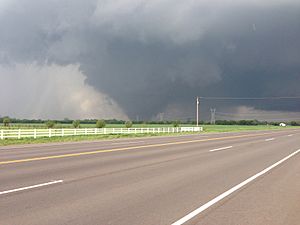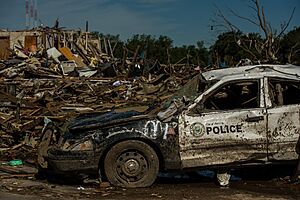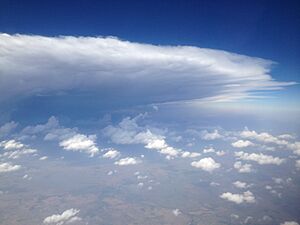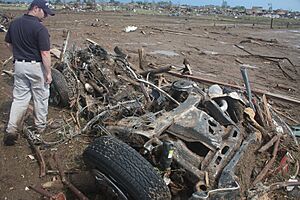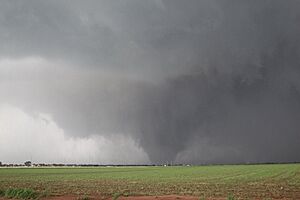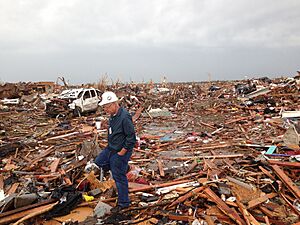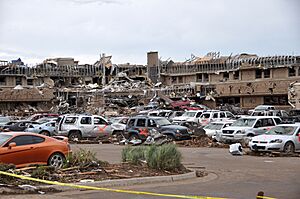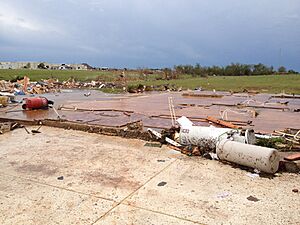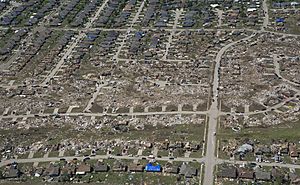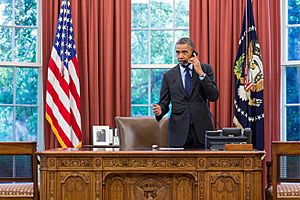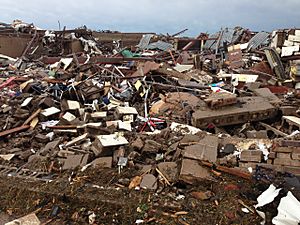2013 Moore tornado facts for kids
The 2013 Moore tornado was a super strong tornado that hit Moore, Oklahoma, on the afternoon of May 20, 2013. It was rated an EF5, which is the highest rating for tornadoes. This powerful storm caused a lot of damage and sadly, people were hurt or lost their lives. Winds reached up to 210 miles per hour (340 km/h). Many people remembered a similar tornado that hit Moore in 1999.
The tornado began near Newcastle, Oklahoma, at 2:56 PM local time. It lasted for 37 minutes and traveled over 17 miles. At its widest, the tornado was 1.3 miles across. It moved through the most populated parts of Moore. This tornado was similar in strength and path to the one that hit the town in 1999.
As of 2024, the 2013 Moore tornado is the most recent tornado to be rated EF5.
Contents
How the Tornado Formed and Moved
The storm that created the tornado started around 2:00 PM CDT. This was less than an hour after a tornado watch was announced. The storm quickly grew stronger. The National Weather Service in Norman then issued a severe thunderstorm warning for several counties. These included parts of Oklahoma City. The storm quickly became a supercell. This type of storm has a strong, rotating updraft. This rotation was clear even before the storm was officially called severe.
Because the storms were expected to be very strong, local TV news channels stopped their regular shows. They began broadcasting live weather updates. Many parents worried about their children. They went to schools in Moore and south Oklahoma City to pick them up early.
At 2:40 PM CDT, a tornado warning was issued. This happened as the storm's rotation grew stronger. The storm was getting close to the Oklahoma City metropolitan area. The storm formed very quickly. This might have been due to a fast-moving downdraft and other storm interactions.
Tornado Starts and Gets Stronger
The tornado touched down at 2:56 PM CDT. It started in northwestern McClain County, near Newcastle. At first, it was a narrow, rope-shaped tornado. It caused EF1 damage to a home and trees. Then, it quickly grew stronger. It hit a neighborhood where several homes were destroyed. Two homes were completely leveled, showing EF4 damage.
At this point, the tornado grew very fast in just two minutes. It changed from a rope shape to a large, wide barrel shape. It then became a huge, wedge-shaped tornado. Debris was picked up and swirled around the funnel. The ground began to be scraped clean in some areas. Other homes nearby had EF3 damage.
By 3:01 PM CDT, the National Weather Service issued a stronger warning. They declared a tornado emergency for southern Oklahoma City and Moore. Storm spotters confirmed that a large, violent tornado was heading their way. Radar detected a tornado debris signature that was one mile wide. This showed the tornado was picking up a lot of material. The storm also created strong straight-line winds of 80 mph (130 km/h) around the tornado.
Through South Oklahoma City
The tornado stayed at least EF3 strength as it crossed the Canadian River. It moved into Cleveland County. A bridge was badly damaged, and parts of it were thrown across the highway. The tornado continued moving east-northeast. It went through the southern part of Oklahoma City towards Moore. It mostly followed Southwest 149th Street.
The tornado grew much wider here. It caused EF4 damage near South May Avenue. Several homes were leveled, and one was swept completely away. A car frame and other parts were found tangled in trees. As the tornado entered south Oklahoma City, traffic jams formed. People were trying to escape or pick up their children from schools. A TV meteorologist, Gary England, urged drivers to use other streets to get out of the tornado's path.
The tornado briefly weakened to EF3 strength. Then, it became EF4 again near Forman Drive. It flattened several homes in rural areas. The tornado hit an oil site, and four oil tanks were blown away. One was never found, and others were thrown far distances.
The tornado kept its strength as it hit the Orr Family Farm and Celestial Acres horse training area. Many horses were killed or badly hurt. Every building at Celestial Acres was destroyed or swept away. The ground was scraped bare, and vehicles were stripped to their frames. Experts thought the tornado was likely EF5 here. However, the buildings' construction only allowed an EF4 rating. A 10-ton propane tank was thrown over half a mile. A shopping center near the farm was also completely leveled.
The tornado continued east, scraping a grassy field. Then, it hit Briarwood Elementary School, destroying it. The damage was first rated EF5. But later studies showed the school had some construction issues. So, the rating was lowered to EF4. Amazingly, no one died at the school. Two large water tanks from the Orr Farm were thrown into this area. One hit the school's roof, possibly weakening it. The other destroyed a home nearby. Past Briarwood Elementary, the tornado got even stronger. It entered crowded areas west of Moore. Many strong brick homes were flattened at EF4 intensity. Two homes were swept completely away, with damage rated EF5.
Through Moore
The tornado continued northeast at EF4 strength. It stripped trees and leveled entire neighborhoods in western Moore. Many homes were flattened east of South Santa Fe Avenue. One home was reduced to a bare slab. It was first rated EF5 but later downgraded to EF4. This was because its anchor bolts were missing nuts and washers.
The tornado then destroyed Plaza Towers Elementary School at EF4 intensity. Sadly, seven children died there. More than a dozen homes south of Plaza Towers Elementary were swept away. But they were found to be nailed, not bolted, to their foundations. So, the damage was rated EF4, though the tornado was extremely strong. Lawns in this area were completely scraped clean. Whole blocks of homes were flattened. Trees were stripped, and cars were mangled. The ground was severely scoured in other neighborhoods. Most of the tornado's deaths happened in the Plaza Towers area.
Further northeast, many cars were piled up at the Moore Medical Center. It suffered EF4 damage. One car was thrown onto the roof. Many homes near the medical center were completely destroyed. This included four well-built brick homes that were swept away. Damage to these four homes was rated EF5. A field behind these homes was deeply scoured. A nearby manhole cover was removed. Many vehicles were mangled and covered in mud. The Warren Theater was not directly hit but was still damaged. A bowling alley was leveled. A 7-Eleven store was completely flattened, and four people died there. The Moore Cemetery was also heavily damaged.
The tornado briefly weakened to EF3 strength. It damaged some businesses near I-35. It crossed the interstate, mangling several vehicles. The tornado regained EF4 intensity on the other side. It tore through more neighborhoods, destroying many homes. A large grassy field between two neighborhoods was scraped bare. One brick home had EF5 damage, with only the foundation left. Very little debris was found from that home. Two vehicles were thrown over 100 yards (91 m) away.
The tornado continued through Moore's eastern neighborhoods. Highland East Jr. High's main building was saved. But its separate gym building was completely destroyed. Lockers from the gym were thrown far into a nearby neighborhood. The Moore Public Schools administration building was also destroyed. The tornado was narrower here but still caused continuous EF4 damage. Many homes in several neighborhoods were hit. A well-built home was reduced to a bare slab, with EF5 damage. Another large, strong home was also swept away at EF5 intensity. Debris was scattered far away, and a vehicle was thrown over 100 yards (91 m).
Weakening and End of the Tornado
Further east, the tornado weakened to EF3 strength. It left Moore, destroying six industrial buildings. A small area of EF4 damage was noted nearby. Two homes and a concrete building were leveled. The tornado then quickly narrowed and weakened. It snapped and uprooted trees. It caused EF2 damage to a farm east of Moore. The house lost its roof, and an outbuilding was destroyed. A pickup truck slid 200 feet (61 m) into a field.
At 3:35 PM CDT, the tornado ended near a tree line. It traveled a total of 13.85 miles (22.29 km) over 39 minutes. It moved at an average speed of 21 mph (34 km/h). At its widest, it was 1,900 yards (1,700 m) across.
The strong updrafts in the storm threw debris from homes and buildings very high. Objects were found at least 10 miles (16 km) outside the tornado's path. Reports said personal items were found as far away as Midwest City.
Impact of the Tornado
The Oklahoma Department of Emergency Management reported that 25 people died. About 1,150 homes were destroyed. This caused an estimated $2 billion in damages. Many people were also injured. Whole neighborhoods were wiped out, and houses were flattened. Most of a neighborhood west of the Moore Medical Center was destroyed. Witnesses said the tornado looked like "a giant black wall of destruction."
Two public schools were hit very hard: Briarwood Elementary School and Plaza Towers Elementary School. A study of Briarwood Elementary found some weaknesses in its structure. These might have caused it to collapse during the tornado. An engineer noted that the building's walls were not reinforced with concrete. Also, connections between walls and beams were weak. Anchor bolts were pulled from the ground. Another engineer said these were common building practices at the time. Current building codes would not guarantee a building could withstand winds over 200 mph (320 km/h).
At Plaza Towers, parents were allowed to pick up their children early. So, only about 75 students and teachers were in the building when the tornado hit. Many took shelter in bathrooms and closets. But in a newer part of the building, seven children died.
The Moore Medical Center was badly damaged. But no one inside was hurt by the tornado. The staff moved 30 patients to other hospitals. Part of I-35 was closed because of debris. On May 21, Moore still had no running water. Over 61,500 homes lost power. More than 100 people were rescued from damaged areas.
The Oklahoma Department of Insurance estimated that insurance claims would be over $1 billion. Some meteorologists said the tornado's energy was like many atomic bombs.
Aftermath and Recovery
Oklahoma Governor Mary Fallin declared a state of emergency on May 20. The Federal Emergency Management Agency (FEMA) sent rescue teams. They helped organize and support rescue efforts. The Oklahoma National Guard was also deployed. Governor Fallin asked then-President Barack Obama for help. He declared a major disaster, sending federal aid to the affected areas.
Governor Fallin did not support a law to require storm shelters in all Oklahoma schools. Before the tornado, only two of Moore's twelve schools had shelters. These were rebuilt with safe rooms after being destroyed in the 1999 tornado.
Several counties received federal money to help prevent future damage. President Obama visited the disaster areas on May 26.
The U.S. Senate held a moment of silence for the victims. Leaders from other countries and Pope Francis sent their condolences. The United Nations offered help. The Canadian Red Cross accepted donations for the American Red Cross.
Many groups and famous people donated to the relief efforts. These included the United Methodist Committee on Relief, Direct Relief, and athletes like Matt Kemp and Kevin Durant. Companies like Continental Resources and Hobby Lobby also gave money. Singer Carrie Underwood also pledged donations.
Moore Mayor Glenn Lewis wanted a law passed. This law would require storm shelters or safe rooms in new homes.
On May 29, 2013, NBC aired a benefit concert called Healing in the Heartland. It was held in Oklahoma City. Country singer Blake Shelton hosted it. Many famous musicians performed, including Miranda Lambert and Usher. The concert raised over $6 million for the United Way.
On June 2, 2013, the Discovery Channel aired a documentary. It was called Mile-Wide Tornado: Oklahoma Disaster. It showed the tornado's impact and compared it to the 1999 tornado.
The Moore City Council proposed changes to its building codes. These included requiring hurricane clips and wind-resistant garage doors. This would help homes withstand winds up to 135 mph (217 km/h). On March 17, 2014, the measure passed. Moore became the first city in the United States to have building codes specifically for tornadoes. These codes are stronger than national standards.
Images for kids
-
Comparison between the preliminary tornado track (red), the 1999 Bridge Creek–Moore tornado (green), and the 2003 Moore–Choctaw tornado (blue); graphic produced by the National Weather Service Norman, Oklahoma.
-
Radar images of the Moore tornado with a debris ball and signature hook echo.
See also
 In Spanish: Tornado de Moore de 2013 para niños
In Spanish: Tornado de Moore de 2013 para niños


